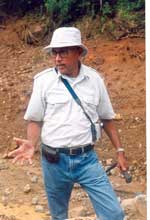
|
On dangerous ground The threat of landslides is looming large with ad hoc building practices being the root cause
Improper and ill-advised land-use practices are resulting in an increasing number of landslides in different parts of the country especially in the hill country, an official has warned. R.M.S Bandara, head of the Landslide Division of the National Building Research Organization(NBRO) says the heavy showers that are being experienced due to the inter monsoon period could lead to landslides but the main reason for the current spate of landslides was incorrect soil-cutting procedures being adopted during construction. Explaining the situation he said when one cuts into slopes the soil has to be supported. But most people fail to do this or do not do it immediately, which could lead to landslides.He said although the NBRO and other local authorities can provide people with information on proper land-use practices, their assistance is hardly sought either through ignorance on the availability of such assistance or in most cases illegal builders deliberately opt to disregard such procedure. In addition to floods that has wreaked havoc in the lives and property of people, landslides and the threat of it has displaced 490 families in Kegalle, Badulla, Ratnapura, Matale and Kandy. Kandy is the worst affected with 153 families being displaced. More than 200 houses have been damaged in Kandy, mostly in the Udapalatha Division with 106 houses damaged. The second highest casualty area was Yatinuwara with 88 houses damaged. The biggest number of displacement occurred in the Gangawata Korala Division, with 103 families displaced. “Though Kandy District is the worst affected due to landslides, 215 families have been displaced in Kegalle District as a result of minor landslides too,” Nimal Hettiarachchi, head of the National Disaster Management Centre(NDMC) said. According to data from the NDMC, 58 families have been displaced in Badulla, 55 in Ratnapura and 13 in Matale. Thirteen people have died due to landslides with deaths being reported from Kandy, Kegalle and Badulla. A senior Geologist at NBRO Kandy, M.I.D.H Wijewickrema said the main reason that Kandy was experiencing so many landslides was improper land use practices. “The population has increased and many houses have been constructed in an ad hoc manner in small land areas. This is the main reason for the landslides,” Mr.Wijewickrema said. Meanwhile Kandy’s Additional Government
Agent A B.E.H.M Sugathadasa commenting on the relief operations
said the Pradeshiya Sabha and several NGOs, were engaged in issuing
dry rations and other items to the displaced. He said cooked food
had been distributed for four days, but now dry rations were being
given to the people as it was difficult to continue providing cooked
food. “We are looking for alternate land to relocate these displaced people,” he said. Badulla District’s disaster management officer Prasanthi Chandrasena said that they were waiting for the rains to cease to evaluate possible alternate locations for the displaced people. He said the evaluation of alternate land for affected commercial enterprises such as shops will be handled by the Urban Council. Though Ratnapura District did not experience severe landslides, there are signs that it could happen in the future. Ratnapura District’s disaster management officer Priyanga Premachancra said, “No major landslides have been reported, although a few minor earthslips were reported in Elapatha, Kollana and Kiriella. However, big cracks are appearing on the ground in some areas, posing the threat of landslides in the future,” he warned.
|
||||||||||||||||||||||||
|| Front
Page | News | Editorial | Columns | Sports | Plus | Financial
Times | International | Mirror | TV
Times | Funday
Times | MediScene || |
| |
Copyright
2006 Wijeya
Newspapers Ltd.Colombo. Sri Lanka. |

